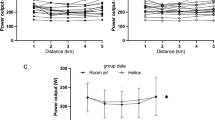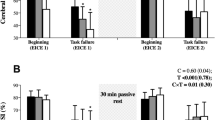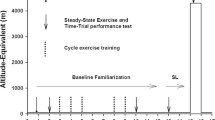Abstract
Purpose
We sought to determine if expiratory flow limitation influences intensive aerobic exercise performance in mild hypoxia.
Methods
Fourteen trained male cyclists were separated into flow-limited (FL, n = 7) and non-FL (n = 7) groups based on the extent of expiratory flow limitation exhibited during maximal exercise in normoxia. Participants performed two self-paced 5-km cycling time trials, one in normoxic (F IO2 = 0.21) and one in mild hypoxic (F IO2 = 0.17) conditions in a randomized, balanced order with the subjects blinded to composition of the inspirate. Percent change from normoxia to hypoxia in average power output (%ΔP TT) and time to completion (%ΔT TT) were used to assess performance.
Results
Hypoxia resulted in a significant decline in estimated arterial O2 saturation and decrements in performance in both groups, although FL had a significantly smaller %ΔP TT (−4.0 ± 0.5 vs. −9.0 ± 1.8 %) and %ΔT TT (1.3 ± 0.3 vs. 3.7 ± 0.9 %) compared to non-FL. At the 5th km of the time trial, minute ventilation did not change from normoxia to hypoxia in FL (3.4 ± 3.1 %) or non-FL (2.3 ± 3.7 %), but only the non-FL reported a significantly increased dyspnea rating in hypoxia compared to normoxia (~9 %). Non-FL athletes did not utilize their ventilatory reserve to defend arterial oxygen saturation in hypoxia, which may have been due to an increased measure of dyspnea in the hypoxic trial.
Conclusion
FL athletes experience less hypoxia-related aerobic exercise performance impairment as compared to non-FL athletes, despite having less ventilatory reserve.



Similar content being viewed by others
Abbreviations
- ERV:
-
Expiratory reserve volume
- F B :
-
Frequency of breathing
- F IO2 :
-
Fraction of inspired O2
- F ECO2 :
-
Fraction of expired CO2
- FEV1 :
-
Forced expired volume in 1 s
- FEV1/FVC:
-
Forced expired volume in 1 s to forced vital capacity ratio
- FL:
-
Flow limited
- FVC:
-
Forced vital capacity
- HR:
-
Heart rate
- IC:
-
Inspiratory capacity
- IRV:
-
Inspiratory reserve volume
- MEF25–75 :
-
Maximal expiratory flow between 25 and 75 % of forced vital capacity
- MFVL:
-
Maximal flow volume loop
- PAO2 :
-
Partial pressure of alveolar oxygen (O2)
- PEFR:
-
Peak expired flow rate
- P TT :
-
Power output during the 5-km time trial
- RPM:
-
Revolutions per minute
- RER:
-
Respiratory exchange ratio
- SaO2/SpO2 :
-
Arterial oxygen saturation/estimated arterial oxygen saturation
- TT:
-
Time trial
- T TT :
-
Time to completion for the 5-km time trial
- V E :
-
Minute ventilation
- V E/VO2 :
-
Ventilatory equivalents for oxygen (O2)
- V E/VCO2 :
-
Ventilatory equivalents for carbon dioxide (CO2)
- VO2max :
-
Maximal oxygen consumption
- V T :
-
Tidal volume
- W:
-
Watts
References
Amann M, Subudhi AW, Walker J, Eisenman P, Shultz B, Foster C (2004) An evaluation of the predictive validity and reliability of ventilatory threshold. Med Sci Sports Exerc 36(10):1716–1722
Amann M, Eldridge M, Lovering A et al (2006) Arterial oxygenation influences central motor output and exercise performance via effects on peripheral locomotor muscle fatigue in humans. J Physiol 575(3):937–952
American Thoracic Society (1995) Standardization of Spirometry, 1994 update. Am J Respir Crit Care Med 152(3):1107–1136
Babb TG (1997a) Ventilation and respiratory mechanics during exercise in younger subjects breathing CO2 or HeO2. Respir Physiol 109(1):15–28
Babb TG (1997b) Ventilatory response to exercise in subjects breathing CO2 or HeO2. J Appl Physiol 82(3):746–754
Babb TG, Rodarte JR (1992) Exercise capacity and breathing mechanics in patients with airflow limitation. Med Sci Sports Exerc 24(9):967–974
Babb TG, Rodarte JR (1993) Estimation of ventilatory capacity during submaximal exercise. J Appl Physiol (1985) 74(4):2016–2022
Bartlett RG Jr, Phillips NE (1962) The velocity volume loop: a composite pulmonary function test. Dis Chest 42:482–488
Borg GA (1982) Psychophysical bases of perceived exertion. Med Sci Sports Exerc 14(5):377–381
Chapman RF (2013) The individual response to training and competition at altitude. Br J Sports Med 47(Suppl 1):i40–i44
Chapman RF, Emery M, Stager JM (1998) Extent of expiratory flow limitation influences the increase in maximal exercise ventilation in hypoxia. Respir Physiol 113(1):65–74
Chapman RF, Emery M, Stager JM (1999) Degree of arterial desaturation in normoxia influences VO2max decline in mild hypoxia. Med Sci Sports Exerc 31(5):658–663
de Koning JJ, Foster C, Bakkum A, Kloppenburg S, Thiel C, Joseph T, Cohen J, Porcari JP (2011) Regulation of pacing strategy during athletic competition. PLoS One 6(1):e15863
Derchak PA, Stager JM, Tanner DA, Chapman RF (2000) Expiratory flow limitation confounds ventilatory response during exercise in athletes. Med Sci Sports Exerc 32(11):1873–1879
Dill DB, Adams WC (1971) Maximal oxygen uptake at sea level and at 3,090-m altitude in high school champion runners. J Appl Physiol 30(6):854–859
Duke JW, Stickford JL, Weavil JC, Chapman RF, Stager JM, Mickleborough TD (2014) Operating lung volumes are affected by exercise mode but not trunk and hip angle during maximal exercise. Eur J Appl Physiol 114(11):2387–2397
Gore CJ, Hahn AG, Scroop GC, Watson DB, Norton KI, Wood RJ, Campbell DP, Emonson DL (1996) Increased arterial desaturation in trained cyclists during maximal exercise at 580 m altitude. J Appl Physiol (1985) 80(6):2204–2210
Gore CJ, Little SC, Hahn AG, Scroop GC, Norton KI, Bourdon PC, Woolford SM, Buckley JD, Stanef T, Campbell DP, Watson DB, Emonson DL (1997) Reduced performance of male and female athletes at 580 m altitude. Eur J Appl Physiol Occup Physiol 75(2):136–143
Guenette JA, Dominelli PB, Reeve SS, Durkin CM, Eves ND, Sheel AW (2010) Effect of thoracic gas compression and bronchodilation on the assessment of expiratory flow limitation during exercise in healthy humans. Respir Physiol Neurobiol 170(3):279–286
Guenette JA, Webb KA, O’Donnell DE (2012) Does dynamic hyperinflation contribute to dyspnoea during exercise in patients with COPD? Eur Respir J 40(2):322–329
Hampson DB, St Clair Gibson A, Lambert MI, Noakes TD (2001) The influence of sensory cues on the perception of exertion during exercise and central regulation of exercise performance. Sports Med 31(13):935–952
Hankinson JL, Odencrantz JR, Fedan KB (1999) Spirometric reference values from a sample of the general U.S. population. Am J Respir Crit Care Med 159(1):179–187
Harms CA, Wetter TJ, St Croix CM, Pegelow DF, Dempsey JA (2000) Effects of respiratory muscle work on exercise performance. J Appl Physiol (1985) 89(1):131–138
Hickey MS, Costill DL, McConell GK, Widrick JJ, Tanaka H (1992) Day to day variation in time trial cycling performance. Int J Sports Med 13(6):467–470
Iandelli I, Aliverti A, Kayser B, Dellaca R, Cala SJ, Duranti R, Kelly S, Scano G, Sliwinski P, Yan S, Macklem PT, Pedotti A (2002) Determinants of exercise performance in normal men with externally imposed expiratory flow limitation. J Appl Physiol (1985) 92(5):1943–1952
Jeukendrup A, Saris WH, Brouns F, Kester AD (1996) A new validated endurance performance test. Med Sci Sports Exerc 28(2):266–270
Johnson BD, Reddan WG, Pegelow DF, Seow KC, Dempsey JA (1991) Flow limitation and regulation of functional residual capacity during exercise in a physically active aging population. Am Rev Respir Dis 143(5 Pt 1):960–967
Johnson BD, Saupe KW, Dempsey JA (1992) Mechanical constraints on exercise hyperpnea in endurance athletes. J Appl Physiol (1985) 73(3):874–886
Johnson BD, Joseph T, Wright G, Battista RA, Dodge C, Balweg A, de Koning JJ, Foster C (2009) Rapidity of responding to a hypoxic challenge during exercise. Eur J Appl Physiol 106(4):493–499
Koskolou MD, McKenzie DC (1994) Arterial hypoxemia and performance during intense exercise. Eur J Appl Physiol Occup Physiol 68(1):80–86
Lawler J, Powers SK, Thompson D (1988) Linear relationship between VO2max and VO2max decrement during exposure to acute hypoxia. J Appl Physiol (1985) 64(4):1486–1492
Marino FE (2012) The limitations of the constant load and self-paced exercise models of exercise physiology. Comp Exerc Physiol 7(4):173–178
McClaran SR, Wetter TJ, Pegelow DF, Dempsey JA (1999) Role of expiratory flow limitation in determining lung volumes and ventilation during exercise. J Appl Physiol (1985) 86(4):1357–1366
Noakes TD (2000) Physiological models to understand exercise fatigue and the adaptations that predict or enhance athletic performance. Scand J Med Sci Sports 10(3):123–145
Noble BJ, Metz KF, Pandolf KB, Cafarelli E (1973) Perceptual responses to exercise: a multiple regression study. Med Sci Sports 5(2):104–109
O’Donnell DE (2006) Hyperinflation, dyspnea, and exercise intolerance in chronic obstructive pulmonary disease. Proc Am Thorac Soc 3(2):180–184
Robertson RJ (1982) Central signals of perceived exertion during dynamic exercise. Med Sci Sports Exerc 14(5):390–396
Romer LM, Haverkamp HC, Amann M, Lovering AT, Pegelow DF, Dempsey JA (2007) Effect of acute severe hypoxia on peripheral fatigue and endurance capacity in healthy humans. Am J Physiol Regul Integr Comp Physiol 292(1):R598–R606
St Gibson AC, Lambert EV, Rauch LH, Tucker R, Baden DA, Foster C, Noakes TD (2006) The role of information processing between the brain and peripheral physiological systems in pacing and perception of effort. Sports Med 36(8):705–722
Sutton JR, Reeves JT, Wagner PD, Groves BM, Cymerman A, Malconian MK, Rock PB, Young PM, Walter SD, Houston CS (1988) Operation Everest II: oxygen transport during exercise at extreme simulated altitude. J Appl Physiol 64(4):1309–1321
Taylor BJ, How SC, Romer LM (2013) Expiratory muscle fatigue does not regulate operating lung volumes during high-intensity exercise in healthy humans. J Appl Physiol 114:1569–1576
Terrados N, Mizuno M, Andersen H (1985) Reduction in maximal oxygen uptake at low altitudes; role of training status and lung function. Clin Physiol 5(Suppl 3):75–79
Tucker A, Stager JM, Cordain L (1984) Arterial O2 saturation and maximum O2 consumption in moderate-altitude runners exposed to sea level and 3,050 m. JAMA 252(20):2867–2871
Ulmer HV (1996) Concept of an extracellular regulation of muscular metabolic rate during heavy exercise in humans by psychophysiological feedback. Experientia 52(5):416–420
Verges S, Bachasson D, Wuyam B (2010) Effect of acute hypoxia on respiratory muscle fatigue in healthy humans. Respir Res 11:109
Volianitis S, McConnell AK, Koutedakis Y, Jones DA (2001) Specific respiratory warm-up improves rowing performance and exertional dyspnea. Med Sci Sports Exerc 33(7):1189–1193
Wilson RC, Jones PW (1991) Long-term reproducibility of Borg scale estimates of breathlessness during exercise. Clin Sci (Lond) 80(4):309–312
Acknowledgments
The authors would like to express their gratitude to the individuals who volunteered to participate in this study and the colleagues who helped with data collection and manuscript preparation.
Conflict of interest
No author claims any conflict of interest from this study or has any relationships with companies or manufacturers. No company will benefit directly from the results of this study.
Author information
Authors and Affiliations
Corresponding author
Additional information
Communicated by Carsten Lundby.
Rights and permissions
About this article
Cite this article
Weavil, J.C., Duke, J.W., Stickford, J.L. et al. Endurance exercise performance in acute hypoxia is influenced by expiratory flow limitation. Eur J Appl Physiol 115, 1653–1663 (2015). https://doi.org/10.1007/s00421-015-3145-5
Received:
Accepted:
Published:
Issue Date:
DOI: https://doi.org/10.1007/s00421-015-3145-5




